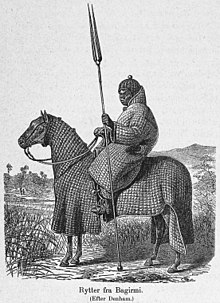Bagirmi (people)
The Bagirmi (also Baghirmi or Baguirmi , own name ɓarma ) are a population group of Chad . They are not a completely homogeneous people, but are divided into several tribes, the actual Bagirmi as well as the Berakou, Disa, Gula, Jaya, Kenga, Morom and Naba. The eponymous tribe speaks Bagirmi , a Nilo-Saharan language , which in turn is divided into several dialects, including Bangri, Dam, Gol and Kibar.
The Bagirmi settle in the plain of Massenya and the Bousso sub-prefecture, which are located in southern Chad in the Chari-Baguirmi region. In 1993 there were 44,800 Bagirmi, another source without a precise date gives the number 96,500. The majority are Muslims, a smaller number seem to believe in spirits called Margai , which are part of the traditional religion of the Kenga related people . While the upper class of the Bagirmi has long been of the Muslim faith, Islam has been on the rise among the simple rural population since around 1970. In contrast to the Fulbe nomads who also live in the Chari-Baguirmi region, the people are sedentary and known as cattle breeders.
The Bagirmi were the state people of the Sultanate of Bagirmi , which existed from the end of the 15th century until 1897 in the savannah southeast of Lake Chad . From the reign of Abdullah IV (1568–1608) this Islamic empire with a king called Mbang at the top was a vassal state of Kanem-Bornus for a long time , but in the meantime also achieved a certain independence and expanded independently during this time. In the 19th century a decline began, which culminated in the destruction of the capital Massenya by troops of the Wadai Empire and finally led to its incorporation into the French colonial empire.
Unlike many other languages in Chad, the relatively small language is hardly threatened by the spread of Arabic , but even serves as a lingua franca in the immediate vicinity.
The German African explorer Heinrich Barth (1821–1865) described the Bagirmi as big, beautiful, strong and clever compared to the Kanuri , but such comparisons must be viewed differently today.
Individual evidence
- ↑ Bagirmi | Ethnologue (Subgroup) ( Memento of the original from September 6, 2015 in the Internet Archive ) Info: The archive link was inserted automatically and has not yet been checked. Please check the original and archive link according to the instructions and then remove this notice. Source: Ethnologue, accessed on October 25, 2015
- ↑ Bagirmi | Ethnologue (English) Source: Ethnologue, accessed on October 25, 2015
- ↑ People Name: Barma Source: PeopleGroups, accessed October 25, 2015
- ↑ Bagirmi - Religion and Expressive Culture (English) Source: Countries and their Cultures, accessed on October 25, 2015
- ↑ Reproduced in: Mario J. Azevedo: The Roots of Violence: A History of War in Chad (= War and Society. Volume 4). Gordon and Breach, Amsterdam 1998, ISBN 90-5699-582-0 , p. 31 ( online ).
